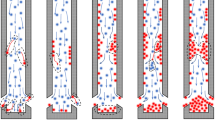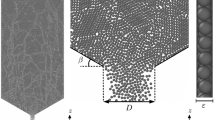Abstract
This study proposes the Test-simulation Method to investigate the formation mechanism of slurry consolidated body in different grouting media under dynamic water conditions, which utilizes the test system to study the basic laws, and the numerical simulation to reveal the mechanism. Firstly, a test system for grouting under dynamic water conditions was developed, which can be used to grout in both porous media and parallel-fissure media. And the effects of water velocity and grouting rate on the slurry-consolidated-body forms were studied by this test system. Secondly, COMSOL Multiphysics was used to simulate the test process, and shapes of the consolidated body in numerical simulation were analyzed and compared with those in the model test, which proved the feasibility of the numerical method. Finally, the variation law of two-phase flow velocity during the grouting process was further studied by numerical simulation, in order to reveal the formation mechanism of the consolidated body. The results show that the slurry consolidated body presents an approximate ‘Fusiform’ shape in the porous medium, while presents a ‘U-shape’ in the parallel-fissure medium. And the final form of the slurry consolidated body is constructed with the joint action of water velocity and grouting rate.
Similar content being viewed by others
References
Bouchelaghem F, Vulliet L (2001) Mathematical and numerical filtration-advection-dispersion model of miscible grout propagation in saturated porous media. International Journal for Numerical and Analytical Methods in Geomechanics 25(12):1195–1227, DOI: https://doi.org/10.1002/nag173
Dang BL, Nguyen-Van V, Tran P, Wahab MA, Lee J, Hackl K, Nguyen-Xuan H (2022) Mechanical and hydrodynamic characteristics of emerged porous Gyroid breakwaters based on triply periodic minimal surfaces. Ocean Engineering 254, DOI: https://doi.org/10.1016/joceaneng2022111392
El Tani M, Stille H (2017) Grout spread and injection period of silica solution and cement mix in rock fractures. Rock Mechanics and Rock Engineering 50(9):2365–2380, DOI: https://doi.org/10.1007/s00603-017-1237-8
Gothäll R, Stille H (2010) Fracture—fracture interaction during grouting. Tunnelling and Underground Space Technology 25(3):199–204, DOI: https://doi.org/10.1016/jtust200911003
Guo W, Zhang M, Sun YH, Li Q, Zhao S, Deng SH (2020) Numerical simulation and field test of grouting in Nong’an pilot project of in-situ conversion of oil shale. Journal of Petroleum Science and Engineering 184, DOI: https://doi.org/10.1016/jpetrol2019106477
Han CH, Zhang WJ, Zhou WW, Guo JB, Yang F, Man XQ, Jiang JG, Zhang CR, Li YJ, Wang Z, Wang H (2020) Experimental investigation of the fracture grouting efficiency with consideration of the viscosity variation under dynamic pressure conditions. Carbonates and Evaporites 35(2), DOI: https://doi.org/10.1007/s13146-020-00568-7
Ivars DM (2006) Water inflow into excavations in fractured rock — A three-dimensional hydro-mechanical numerical study. International Journal of Rock Mechanics and Mining Sciences 43(5):705–725, DOI: https://doi.org/10.1016/jijrmms200511009
Li SC, Liu RT, Zhang QS, Zhang X (2016) Protection against water or mud inrush in tunnels by grouting: A review. Journal of Rock Mechanics and Geotechnical Engineering 8(5):753–766, DOI: https://doi.org/10.1016/jjrmge201605002
Li SC, Pan DD, Xu ZH, Lin P, Zhang YC (2020a) Numerical simulation of dynamic water grouting using quick-setting slurry in rock fracture: The sequential diffusion and solidification (SDS) method. Computers and Geotechnics 122, DOI: https://doi.org/10.1016/jcompgeo2020103497
Li HY, Zhang YC, Wu J, Zhang XY, Zhang LW, Li ZF (2020b) Grouting sealing mechanism of water gushing in karst pipelines and engineering application. Construction and Building Materials 254, DOI: https://doi.org/10.1016/jconbuildmat2020119250
Li SC, Zhang X, Zhang QS, Sun KG, Xu Y, Zhang WJ, Li HY, Liu RT, Li P (2011) Research on mechanism of grout diffusion of dynamic grouting and plugging method in water inrush of underground engineering. Chinese Journal of Rock Mechanics and Engineering 30(12):2377–2396 (in Chinese)
Lisa H, Christian B, Åsa F, Gunnar G, Johan F (2012) A hard rock tunnel case study: Characterization of the water-bearing fracture system for tunnel grouting. Tunnelling and Underground Space Technology 30:132–144, DOI: https://doi.org/10.1016/jtust201202014
Liu RT (2012) Study on diffusion and plugging mechanism of quick setting cement based slurry in underground dynamic water grouting and its application PhD Thesis, Shandong University, Shandong, China (in Chinese)
Liu XF, Wang JG, Huang K, Li FY (2019) Experimental study on dynamic water grouting of modified water-soluble polyurethane. KSCE Journal of Civil Engineering 23(9):3897–3906, DOI: https://doi.org/10.1007/s12205-019-0086-2
Niessner J, Berg S, Hassanizadeh SM (2011) Comparison of two-phase darcy’s law with a thermodynamically consistent approach. Transport in Porous Media 88(1):133–148, DOI: https://doi.org/10.1007/s11242-011-9730-0
Rabczuk T, Belytschko T (2004) Cracking particles: A simplified meshfree method for arbitrary evolving cracks. International Journal for Numerical Methods in Engineering 61(13):2316–2343, DOI: https://doi.org/10.1002/nme1151
Rabczuk T, Belytschko T (2007) A three dimensional large deformation meshfree method for arbitrary evolving cracks. Computer Methods in Applied Mechanics and Engineering 196(29–30):2777–2799, DOI: https://doi.org/10.1016/jcma200606020
Rabczuk T, Zi G, Bordas S, Nguyen-Xuan H (2010) A simple and robust three-dimensional cracking-particle method without enrichment. Computer Methods in Applied Mechanics and Engineering 199(37–40): 2437–2455, DOI: https://doi.org/10.1016/jcma201003031
Saeidi O, Stille H, Torabi SR (2013) Numerical and analytical analyses of the effects of different joint and grout properties on the rock mass groutability. Tunnelling and Underground Space Technology 38:11–25, DOI: https://doi.org/10.1016/jtust201305005
Sui WH, Liu JY, Hu W, Qi JF, Zhan KY (2015) Experimental investigation on sealing efficiency of chemical grouting in rock fracture with flowing water. Tunnelling and Underground Space Technology 50:239–249, DOI: https://doi.org/10.1016/jtust201507012
Vu-Huu T, Le-Thanh C, Nguyen-Xuan H, Abdel-Wahab M (2022) Polygonal finite element for two-dimensional lid-driven cavity flow. Computers, Materials & Continua 70(3):4217–4239, DOI: https://doi.org/10.32604/cmc2022020889
Vu-Huu T, Phung-Van P, Nguyen-Xuan H, Abdel-Wahab M (2018) A polytree-based adaptive polygonal finite element method for topology optimization of fluid-submerged breakwater interaction. Computers & Mathematics with Applications 76(5):1198–1218, DOI: https://doi.org/10.1016/jcamwa201806008
Wang QB, Zhu QK, Shao TS, Yu XG, Xu SY, Zhang JJ, Kong QL (2018) The rheological test and application research of glass fiber cement slurry based on plugging mechanism of dynamic water grouting. Construction and Building Materials 189:119–130, DOI: https://doi.org/10.1016/jconbuildmat201808081
Xu ZH, Pan DD, Lin P, Zhang QS, Li HY, Zhang YC (2021) Numerical investigation of flow control technology for grouting and blocking of flowing water in karst conduits. International Journal for Numerical and Analytical Methods in Geomechanics 45(12):1712–1738, DOI: https://doi.org/10.1002/nag3221
Yang P, Liu YH, Gao SW, Xue SB (2020) Experimental investigation on the diffusion of carbon fibre composite grouts in rough fractures with flowing water. Tunnelling and Underground Space Technology 95, DOI: https://doi.org/10.1016/jtust2019103146
Zhou S, Zhuang X, Rabczuk T (2019) Phase-field modeling of fluid-driven dynamic cracking in porous media. Computer Methods in Applied Mechanics and Engineering 350:169–198, DOI: https://doi.org/10.1016/jcma201903001
Zhuang X, Zhou S, Sheng M, Li G (2020) On the hydraulic fracturing in naturally-layered porous media using the phase field method. Engineering Geology 266, DOI: https://doi.org/10.1016/jenggeo2019105306
Zou LC, Håkansson U, Cvetkovic V (2018) Two-phase cement grout propagation in homogeneous water-saturated rock fractures. International Journal of Rock Mechanics and Mining Sciences 106:243–249, DOI: https://doi.org/10.1016/jijrmms201804017
Acknowledgments
This work was supported by the National Natural Science Foundation of China (grant number 51574223).
Author information
Authors and Affiliations
Corresponding author
Rights and permissions
About this article
Cite this article
Xu, C., Han, L. Formation Mechanism of Slurry Consolidated Body in Different Grouting Media under Dynamic Water Conditions by the Test-simulation Method. KSCE J Civ Eng 27, 169–180 (2023). https://doi.org/10.1007/s12205-022-0709-x
Received:
Revised:
Accepted:
Published:
Issue Date:
DOI: https://doi.org/10.1007/s12205-022-0709-x




